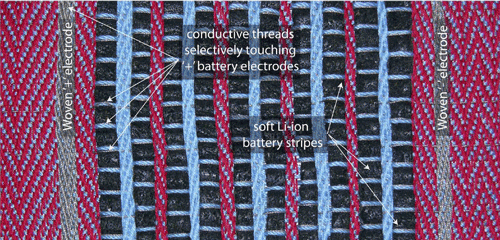How to: Weave a flexible battery into fabric material
Researchers develop new way to really stand out from crowd
A team of researchers at the Polytechnic School of Montreal have figured out a way to discreetly weave a flexible battery into textile fabrics.

This new technology is vastly different from other “powered-up” garments: shirts with LEDs generally have an obtrusive battery pack sewn into them; vests with solar panels have batteries laid either on top or underneath.
What the Poly team did here is they figured out a way to create a flexible, thread-like battery that can be easily interlaced with fabric materials.
How they did it:
To create the battery, the team stuck a solid polyethylene oxide electrolyte between a strain-free LiFePO4 cathode and Li4 Ti5 O12 anode. The three layers were placed in a prepared liquid polymer solution, which was evaporated to allow for a consolidation of the layers. Given that they’re all thermoplastic materials, the battery was able to be sliced and stretched into a thread-like, flexible material with only a slight application of heat. There were no liquid electrolytes necessary in this process whatsoever.
What they discovered is that each strip turned out to be a 0.6-V battery in and of itself. Once they were the appropriate size, the strips were woven in with cotton fabric materials and conductive threads of copper and aluminum were applied to connect the batteries in series.

Battery strips woven into fabric and connected with conductive threads.

Eight polymer battery strips incorporated into a woven piece of fabric, altogether providing enough power to light a 3-V LED.
Outlook:
The team claims that a full garment could provide as much as a couple of hundred volts of electricity. While a shirt or pair of pants packing this much punch might have some trend setters a bit weary to don the new garb, researchers foresee a chance to carve out a niche market with bags, backpacks, and medical-monitoring garments capable of carrying built-in power. They feel that these items could be particularly useful in emergency situations, such as sending out an emergency signal or defibrillating a patient.
Before they figure out how best to market the technology, though, Prof. Maksim Skorobogatiy, who leads this project, and his team plan on tackling the next step in their project: figuring out a way to waterproof the fabric and making it washable. ■
Credit for images and information :
Y. Liu, S. Gorgutsa, C. Santato, and M. Skorobogatiy “Flexible, Solid Electrolyte-Based Lithium Battery Composed of LiFePO4 Cathode and Li4Ti5O12 Anode for Applications in Smart Textiles,” Journal of The Electrochemical Society, vol. 159 (4), pp. A349-A356 (2012)
Available online via : photonics.phys.polymtl.ca/Overviews/Smart_Textiles_CAP_2011.pdf
Advertisement
Learn more about Electronic Products Magazine





